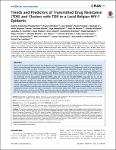Trends and Predictors of Transmitted Drug Resistance (TDR) and Clusters with TDR in a Local Belgian HIV-1 Epidemic
Pineda-Peña, Andrea-Clemencia
Schrooten, Yoeri
Vinken, Lore
Ferreira, Fossie
Li, Guangdi
Trovão, Nídia Sequeira
Khouri, Ricardo
Derdelinckx, Inge
Munter, Paul De
Kücherer, Claudia
Kostrikis, Leondios G.
Nielsen, Claus
Littsola, Kirsi
Wensing, Annemarie
Stanojevic, Maja
Paredes, Roger
Balotta, Claudia
Albert, Jan
Boucher, Charles
Gomez-Lopez, Arley
Wijngaerden, Eric van
Ranst, Marc van
Vercauteren, Jurgen
Vandamme, Anne-Mieke
Laethem, Kristel van
We aimed to study epidemic trends and predictors for transmitted drug resistance (TDR) in our region, its clinical impact and its association with transmission clusters. We included 778 patients from the AIDS Reference Center in Leuven (Belgium) diagnosed from 1998 to 2012. Resistance testing was performed using population-based sequencing and TDR was estimated using the WHO-2009 surveillance list. Phylogenetic analysis was performed using maximum likelihood and Bayesian techniques. The cohort was predominantly Belgian (58.4%), men who have sex with men (MSM) (42.8%), and chronically infected (86.5%). The overall TDR prevalence was 9.6% (95% confidence interval (CI): 7.7–11.9), 6.5% (CI: 5.0–8.5) for nucleoside reverse transcriptase inhibitors (NRTI), 2.2% (CI: 1.4–3.5) for non-NRTI (NNRTI), and 2.2% (CI: 1.4–3.5) for protease inhibitors. A significant parabolic trend of NNRTI-TDR was found (p = 0.019). Factors significantly associated with TDR in univariate analysis were male gender, Belgian origin, MSM, recent infection, transmission clusters and subtype B, while multivariate and Bayesian network analysis singled out subtype B as the most predictive factor of TDR. Subtype B was related with transmission clusters with TDR that included 42.6% of the TDR patients. Thanks to resistance testing, 83% of the patients with TDR who started therapy had undetectable viral load whereas half of the patients would likely have received a suboptimal therapy without this test. In conclusion, TDR remained stable and a NNRTI up-and-down trend was observed. While the presence of clusters with TDR is worrying, we could not identify an independent, non-sequence based predictor for TDR or transmission clusters with TDR that could help with guidelines or public health measures.
Dateien zu dieser Publikation
Keine Lizenzangabe

